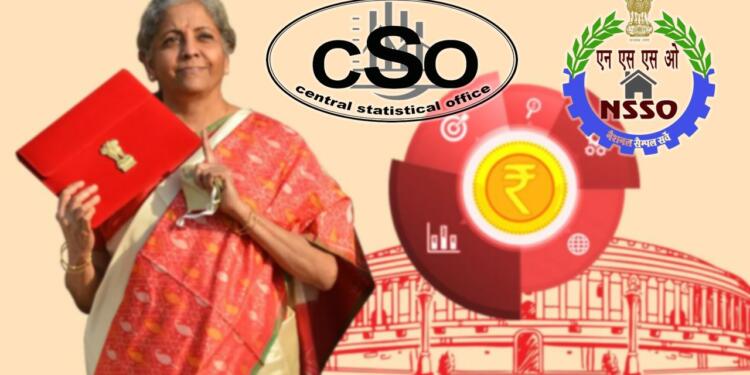Budget 2023 is on the horizon. More than 1.3 billion people have high hopes from the government. The government is trying its best to get the most out of the available resources. But, what if there are discrepancies in SWOT analysis? Things come crashing down. If we don’t improve our data collection scenario, the question of credibility lurks over our heads.
Sources of data in India
The major source of data is the Census of India itself. The questionnaire contained in the process covers many socio-economic issues contained in the NSSO as well. For instance, Census of 2021 tracks availability of facilities such as bathing area, kitchen, LPG, Internet, four and two wheelers and nutrients (main cereal).
There are a total of 31 such metrics. The Registrar General and Census Commissioner of India arranges, conducts and analyzes the results of Census.
The problem with the Census is that it is static, and its data is available only after a decade. Basing growth assumptions on it risks irrelevance. Therefore the Ministry of Statistics and Programme Implementation (MoSPI) also collects data.
As the name suggests, it has two wings. One called the National Statistics Office (NSO), has the Central Statistical Office (CSO), the Computer center and the National Sample Survey Office (NSSO) to execute statistics’ collection.
Also read: Indian economy is soaring and it’s an optimistic sign before Budget
It is the NSSO on whose shoulders the responsibility of collecting large-scale surveys on various socio-economic issues lies. These include employment, unemployment, housing conditions, domestic tourism, drinking water, sanitation, land and livestock holdings, social consumption, health, domestic tourism expenditure, labour force, construction, industries and manufacture. The period for sample collection varies between six months to one year.
Other data sources include state governments, private entities, RBI surveys and respective ministries. These sources mainly aid in analyzing data related to industrialisation. MOSPI compiles these data for the purpose for which it has been tasked.
It is aided by Big data analysis, artificial intelligence and statistical departments of renowned institutions, including Indian Statistical Institute (ISI), IITs, IIMs. Out of these, only ISI is specifically dedicated to statistical analysis. All others have departments for it.
Also read: Just before budget, Modi government announces its fiscal intentions
Problems with data collection
This is one of the big hurdles in data collection. India does not have institutions which are large enough to cater to 1.35 billion people. Periodic surveys like Periodic Labour Force Surveys, Consumer Confidence Survey, Inflation Expectations Survey of Households, National Family Health Survey, among others, require a lot of manpower on the ground.
There are mainly two reasons behind it. First, they are periodic and their calculations hold significance. Second, people on ground rarely trust these surveyors with their information. As a result, there is a lot of falsity in the data.
Falsity and impracticality can also be attributed to a smaller sample size, which is again attributed to less manpower. The RBI’s Consumer Confidence Survey was initially conducted only in six metropolitan areas. In 2018, it was expanded to 13 cities. Even after that, only 6,089 responses were counted in the latest round of the survey.
Similarly, the latest version of the Periodic Labour Force Survey relied on less than 45,000 households and 1,73,271 respondents to assess the situation of employment in India.
The government is well aware of the problem. It is one of the reasons behind the Modi government’s decision to not release the findings of 2017-18 NSSO survey. The problem had once crept in GDP data too. Prior to the 2019 budget, the Finance Ministry estimated that nominal GDP would grow by 12 per cent while inflation would rise by 4%.
It would put real GDP growth at 8 per cent. It had to accept its fault when the GDP growth rate was recorded at 3.7 per cent. It had upset all other budget calculations. Luckily, the government had a second opportunity to present its full-year budget after the General elections.
Also read: Budget 2023: Long wait for middle class is going to end now
Government’s efforts
The Vajpayee government had formed C. Rangarajan commission, which has recommended to establish a permanent National Commission on Statistics. Based on it, National Statistical Commission (NSC) is there. It was given autonomous status in order to enable it to collect data from State and Central government departments.
Statutory status would give it legal teeth, which could create problems in coordinating with other bodies. Despite that, credibility issue remained, and India, being a follower of UN Statistical Commission led systems, can’t afford this distrust.
Towards the fag end of 2019, the Modi government introduced the National Statistical Commission (NSC) Bill, 2019. It envisages a position called Chief Statistician of India. Virtually everything under the ambit of the data spectrum, including collection, audit, standardisation, rationalisation will be under his/her command. Due care has been taken to maintain the independence of the NSC.
The bill has not seen the light of the day. Even if it eventually does, it would remain defanged until there is a big monetary investment on the statistical infrastructure of the country. There are some encouraging reports, such as India’s improved ranking in global scientific publications and new education policy. It is yet to be seen how much they change the face of data collection in the country.
Support TFI:
Support us to strengthen the ‘Right’ ideology of cultural nationalism by purchasing the best quality garments from TFI-STORE.COM





























